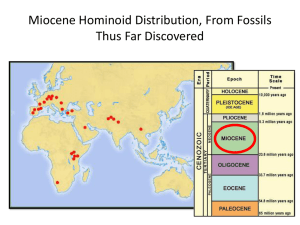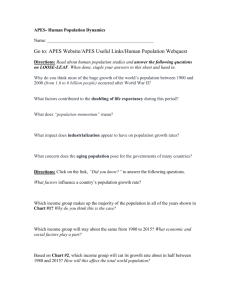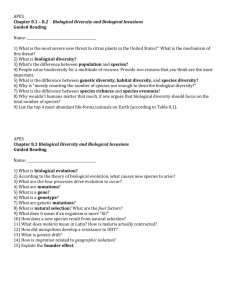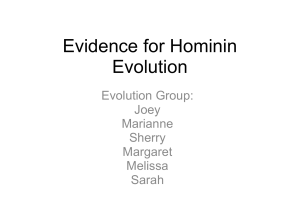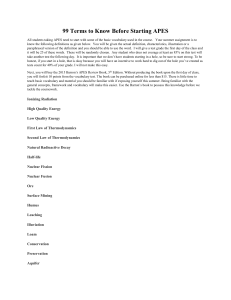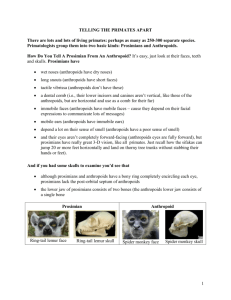0680-4 Hominoids
advertisement
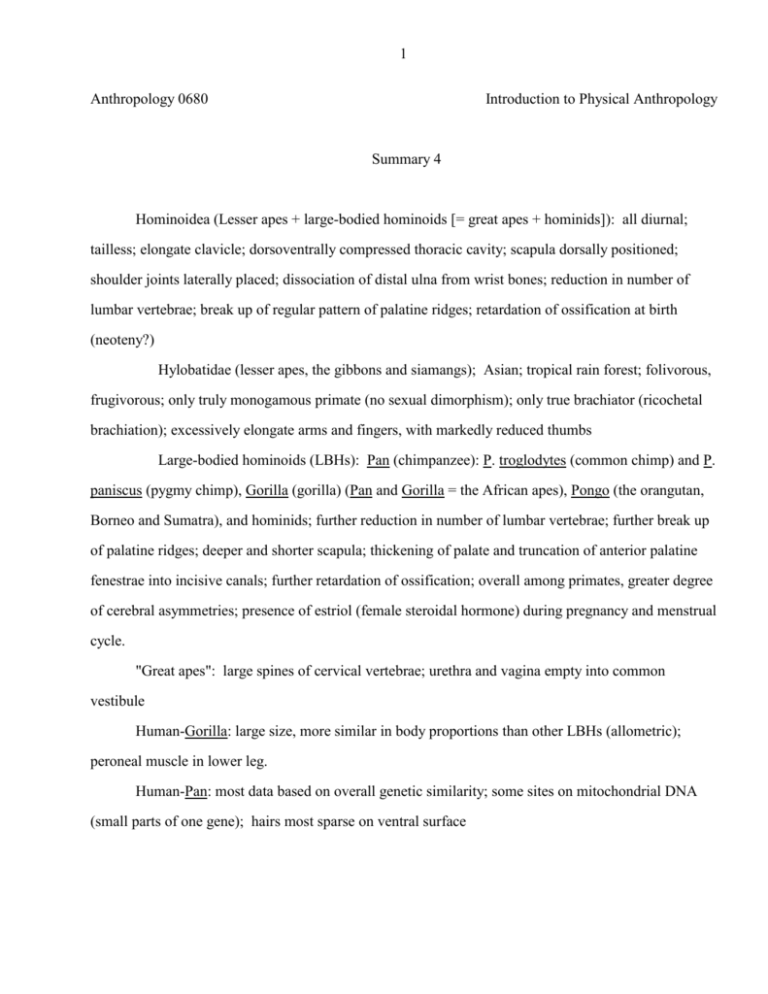
1 Anthropology 0680 Introduction to Physical Anthropology Summary 4 Hominoidea (Lesser apes + large-bodied hominoids [= great apes + hominids]): all diurnal; tailless; elongate clavicle; dorsoventrally compressed thoracic cavity; scapula dorsally positioned; shoulder joints laterally placed; dissociation of distal ulna from wrist bones; reduction in number of lumbar vertebrae; break up of regular pattern of palatine ridges; retardation of ossification at birth (neoteny?) Hylobatidae (lesser apes, the gibbons and siamangs); Asian; tropical rain forest; folivorous, frugivorous; only truly monogamous primate (no sexual dimorphism); only true brachiator (ricochetal brachiation); excessively elongate arms and fingers, with markedly reduced thumbs Large-bodied hominoids (LBHs): Pan (chimpanzee): P. troglodytes (common chimp) and P. paniscus (pygmy chimp), Gorilla (gorilla) (Pan and Gorilla = the African apes), Pongo (the orangutan, Borneo and Sumatra), and hominids; further reduction in number of lumbar vertebrae; further break up of palatine ridges; deeper and shorter scapula; thickening of palate and truncation of anterior palatine fenestrae into incisive canals; further retardation of ossification; overall among primates, greater degree of cerebral asymmetries; presence of estriol (female steroidal hormone) during pregnancy and menstrual cycle. "Great apes": large spines of cervical vertebrae; urethra and vagina empty into common vestibule Human-Gorilla: large size, more similar in body proportions than other LBHs (allometric); peroneal muscle in lower leg. Human-Pan: most data based on overall genetic similarity; some sites on mitochondrial DNA (small parts of one gene); hairs most sparse on ventral surface 2 Pan-Gorilla: morphologies of "knuckle walking" (tightly bound wrist bones, distal end of radius "screws" into carpals, short flexor tendons of fingers/wrist, articular surface extends over head of metacarpal, first phalanx hyperextends over head of metacarpal, well-defined elbow joint articulations) Human-African ape: most reduced palatine ridges; previously believed that frontal sinuses (derived from ethmoid) were unique to these hominoids (not so, found among Miocene forms); sometime development of ear lobes Human-orangutan: single incisive foramen; foramen lacerum in base of skull; further retardation of onset of ossification; greatest degree of cerebral asymmetries (frontal/occipital lobes, and Sylvian sulcus); highest levels of estriol during pregnancy and menstrual cycle (4-5 times greater than African apes); relative to female body size, longest gestation lengths; farthest separated mammary glands; grow the longest hair of any primate; lack keratinized ischial callosities Miocene forms: Proconsul: at least 2 species; mid-Miocene E. Africa; previously thought to be related to LBHs, or even the African apes, specifically; probably sister taxon to LBHs Kenyapithecus: in 1960s, Simons sunk into genus, Ramapithecus; now recognized as distinct; seems to be a LBH, but specific relationships unclear; mid-Miocene E. Africa. Ramapithecus: mid-Miocene, Siwaliks, Indo-Pakistan; genus proposed in 1930s by Lewis as possible hominid ancestor; this idea promoted in 1960-80s by Simons and Pilbeam; sunk into prior genus Sivapithecus in 1980 by Andrews and Tekkaya. Sivapithecus: mid (Indo-Pakistan)-late (Turkey) Miocene; genus proposed in early 20th c by Pilgrim; in 1960-70s, believed to be ancestral to the orangutan; new facial/cranial specimens (1980s and after) confirm relationship to orangutan (e.g. long slitlike single incisive foramen; very long, narrow nasal bones and narrow interorbital distance; tall, vertically ovoid orbits bearing low-mounded rims; airorhynchous [as opposed to klinorhynchous]; small, pear-shaped nasal aperture; flat, deep, anteriorly facing zygomas); extreme sexual dimorphism. 3 Gigantopithecus: Plio-Pleistocene (Indo-Pakistan)-mid-late Pleistocene (China, Vietnam); largest known LBH (much larger than gorilla); during 1960-70s, proposed by some as ancestral hominid (instead of Ramapithecus); now appears to belong to the orangutan clade. Dryopithecus: genus named in mid-1800s on specimen from possible mid-Miocene locality, s. France; subsequently thought of as possible ancestor of all extant LBHs; during 1950-70s, subfamily, Dryopithecinae, used to subsume all Miocene hominoids; now appears to belong to the orangutan clade; extreme sexual dimorphism. Lufengpithecus: late Miocene, s. China; discovered in 1970s; appears to be related to the orangutan clade; greatest expression of sexual dimorphism among primates (fossil and living).

